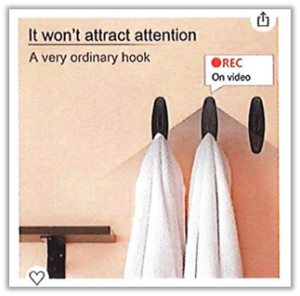A federal court in West Virginia recently ruled that a negligence claim could proceed against Amazon related to a spy camera used to take unsolicited photos of a teenage girl. M.S. v. Amazon.com, Inc., No. 3:23-cv-0046, 2023 U.S. Dist. LEXIS 213236 (S.D. W. Va. Nov. 30, 2023). The negligence claim is specifically interesting for subrogation professionals as it potentially provides an additional avenue for recovery against Amazon in addition to a product liability claim.
In 2021, the plaintiff, M.S. (a minor), visited the United States as a foreign-exchange student. During her stay, she lived with Darrel Wells, a 55-year-old man. Mr. Wells purchased a spy camera that was disguised as a bathroom towel hook on Amazon. The camera was listed for sale by an unknown third party and satisfied through the “Fulfillment by Amazon” program. The product description showed the camera serving as a towel hook with the caption: “It won’t attract any attention[:] A very ordinary hook,” as shown in the photo below from the pleading.

The camera was motion-activated and did not alert individuals it was recording. Mr. Wells installed the camera in M.S.’s private bathroom and took unsolicited photos of her.
M.S. filed a lawsuit against Amazon alleging negligence, among other claims. The court denied Amazon’s motion to dismiss the negligence claim pursuant to Rule 12(b)(6). Although M.S. asserted other claims against Amazon, the negligence claim is specifically interesting for subrogation professionals because it is different from the traditional product liability claim asserted against Amazon in property subrogation cases.
In evaluating the negligence claim, the court rejected Amazon’s argument that it owed no duty of care to M.S. as it is an online store that merely connects buyers and sellers, finding that the plaintiff alleged that Amazon’s involvement in the sale of the camera ran much deeper. The plaintiff alleged that Amazon failed to properly inspect the camera on three separate occasions before it was sold to Mr. Wells. First, the plaintiff alleged the camera was inspected by Amazon’s “Product Safety Team,” which investigates and acts on reported safety complaints and incidents to protect customers from the risks of injury related to products sold on Amazon’s website. Second, the plaintiff alleged the camera was inspected by Amazon’s “Dangerous Goods Team” because the camera contained lithium-ion batteries. Lastly, the plaintiff alleged the camera was inspected as part of Amazon’s “Fulfillment by Amazon” program, which provides logistics for third-party products sold on the website. In addition, with respect to Amazon’s usual argument that it merely published the content of others, the plaintiff alleged that Amazon exercised control over the camera’s product description, including photos encouraging the use of camera in a private bathroom as a towel hook.
The court determined that the plaintiff’s allegations “permit the inference” that Amazon knew that its acts or omissions might expose others to a foreseeable risk that a third party would use the camera as advertised – to secretly record a person in a private bathroom by using the camera as a towel hook. Although the court admitted that West Virginia courts have yet to apply tort principles to Amazon’s “novel business model,” it explained that it could look to other jurisdictions for guidance.
The content on Amazon’s website and the way in which a product is sold may provide a subrogating carrier an avenue for pursuing a negligence claim, in addition to any potential product liability claims, against Amazon. To pursue Amazon, a subrogation professional must review the product listing and customer reviews on Amazon’s website. The product listing may contain misleading, questionable, or false information regarding the quality, purpose or capabilities of the product. In addition, customer reviews may contain accounts from prior users regarding issues with the product that, arguable, put Amazon on notice. This content, available on Amazon’s website, may reveal a foreseeable risk that leads to a duty owed by Amazon to its customers (i.e., the subrogating carriers’ insureds). A subrogation professional must also determine whether the product was sent through the “Fulfillment by Amazon” program, which creates additional support for the assertion that Amazon knew or should have known that the product posed a foreseeable risk of injury. A thorough investigation of the product, Amazon’s inspection process and its control over the published content for the product may allow a subrogating carrier to successfully plead and pursue a negligence action against Amazon, in addition to a product liability claim

